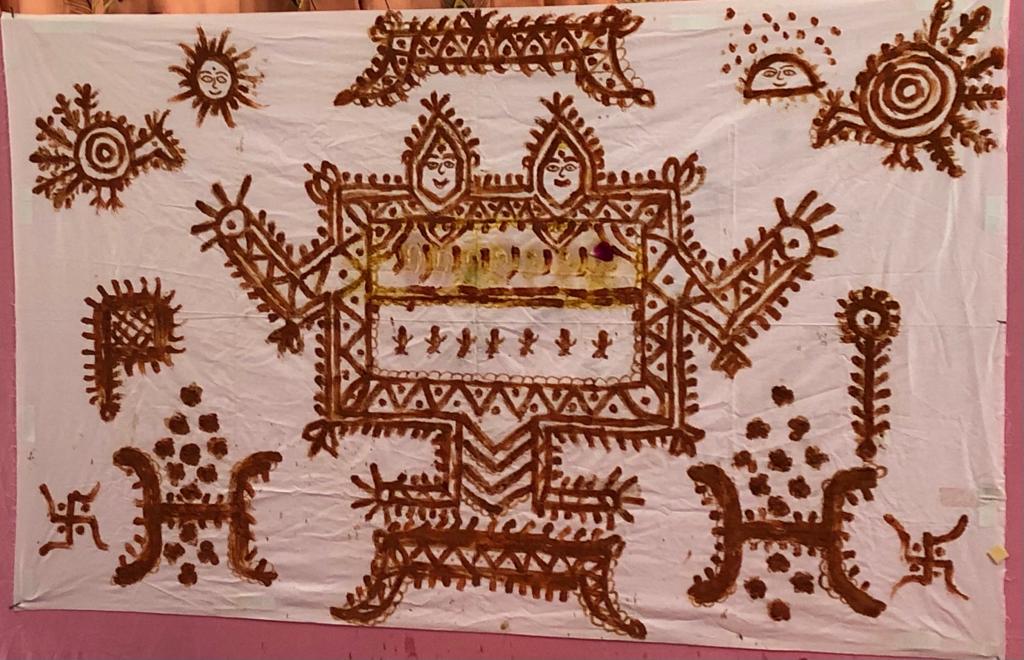
History of Matrika Poojan

About 10,000-12,000 years ago, human civilization learned farming, which in the initial phase was dominated by paddy (rice), maize, corn and wheat. With the advent of agriculture, humans were now able to grow crops (grains) themselves. This achievement inspired people to build houses and settle down in places suitable for farming (especially on the banks of rivers). Now large groups of humans started living together and this led to the emergence of small settlements and then villages. Rearing of animals also started for farming and security. Milking also started from these animals.
This was the time when humans started coming in more contact with each other and also with their domesticated animals. As the grain production from farming started increasing, the need to go hunting for food decreased. The hard work involved in farming started putting stress on the joints of the human body due to which “joint disorders/arthritis” started. Also, since the diet was now more focused on rice, corn, maize and wheat, it also led to metabolic disorders (such as diabetes) in the body.
On the other hand, humans living in large groups and domesticating animals increased due to which outbreaks of communicable diseases started increasing. The diseases spread by humans to humans and the diseases transmitted by animals to humans kept on increasing. Consumption of raw milk from diseased cows and goats also led to increase in diseases. The infestation of rats and mosquitoes in the fields also increased. With all this the incidence of diseases like Tuberculosis, malaria, plague and many other deadly diseases increased. Metabolic disorders also reduce person's ability to fight disease. Natural disasters have always been beyond anyone's control. In the absence of any treatment the death rate started increasing.
Perhaps this was the same time when humans began to fear and believe that all these disasters were “some kind of wrath” that was happening due to some mistake of theirs. This cannot be said with certainty, but perhaps this was the time when humans started believing that his ancestors could save them from these disasters. During this period, after death, the body was buried in some part of the house. Gradually, some part (remains) of these ancestors were taken out and started being worshiped and requests were made to save them from calamities.
Due to continuous exposure to microorganisms, natural resistance to these microorganisms started developing in humans. Disasters began to be controlled partially, if not completely. This gave rise to the belief that all this was happening due to the worship of ancestors and that these ancestors were protecting that settlement. Here there is a confluence of belief and reality. And in this way gradually the ancestors started getting the status of deities.
During this phase, to avoid natural disasters, nature began to be worshipped and revered in various forms (Sun, Moon, Fire, Land, Ocean, Rivers, Ponds, Trees, Animals etc.). Anyone from whom a human being could achieve anything started being worshipped. Efforts were made to please even those who posed any threat to humans.
Over time, experiences began to be written down and told as stories that future generations heard, read, and believed. The ancestors became deities and with time, some of the personalities born in these settlements/villages/cities did something so extraordinary that they appeared to embody the divine and deities themselves. These incarnations of divinity were later referred to as avatars (incarnations of God). In Indian history the personalities like Rama and Krishna were probably these avatars. In places like Rome, the rulers even proclaimed themselves as gods or divine avatars. Despite these various forms, the tradition of venerating ancestors as deities persisted, and it continues to endure.
In this lineage, the emergence of "goddesses" took place.These were the embodiments of feminine power that protected families, communities, villages, and cities from all forms of calamity, disaster, outbreak, crisis and adversity. In ancient civilizations (such as Indus Valley civilizations), “Matrika” and “ Types of “Matrika Puja” are found. Some scholars believe that the Matrikas are rural goddesses of the non-Aryan tradition, while on the other hand there is also a belief that the Matrikas may have emerged inspired by the Yaksha tradition. There are different opinions regarding the number of these Matrikas, according to one opinion their number is seven, on the basis of which they are called Saptamatrika. At some places, she is worshiped as Ashtamatrika, especially in Nepal.
Since ancient times, the worship and invocation of ancestors is done in the form of “Devata Pujan” and the worship and invocation of feminine power is done in the form of “Matrika Pujan”. “Deity worship/Devta Poojan” (Ratavare) is performed when a child is born. “Matrika Puja” is performed at the time of Yajnopavit (Yagyopaveet/Janeyu) and marriage. In these pujas, the entire clan comes together and worships their clan deities and/or matrikas and prays that the clan ancestors (deities) and matrikas protect the clan from any evil and remove all obstacles. In this, the eldest member of the clan offers a stream of ghee on the deities or Matrika and every member of that clan forms a line (queue) by touching each other with their hands. This is called Vasodhara. This symbolizes that the entire clan is connected to each other spiritually, physically and genetically. Generally, all cultures have a tradition of remembering or worshiping their ancestors in some form or the other.







